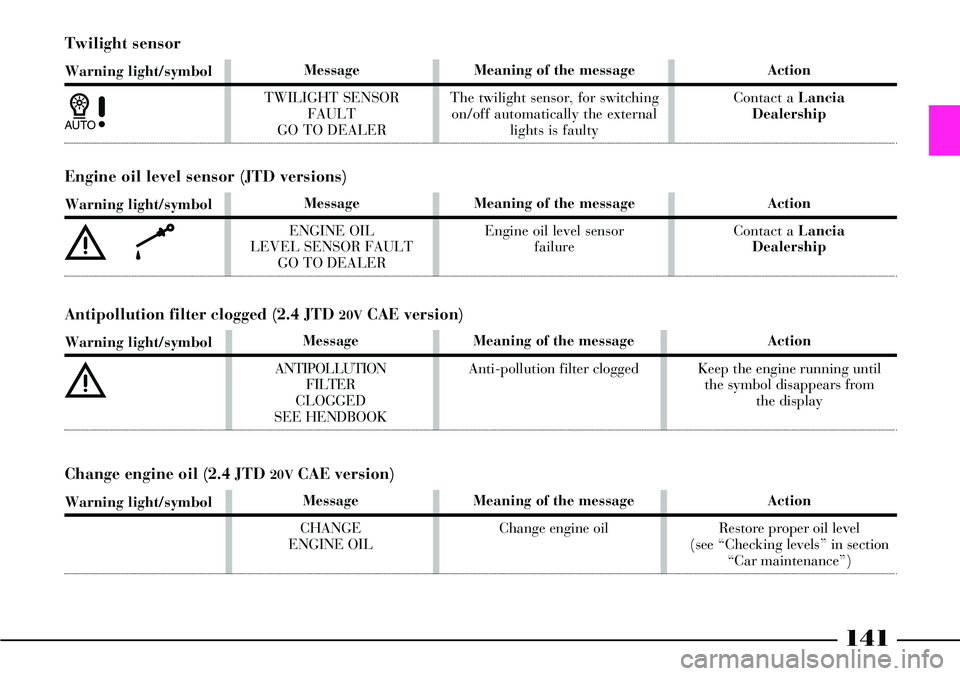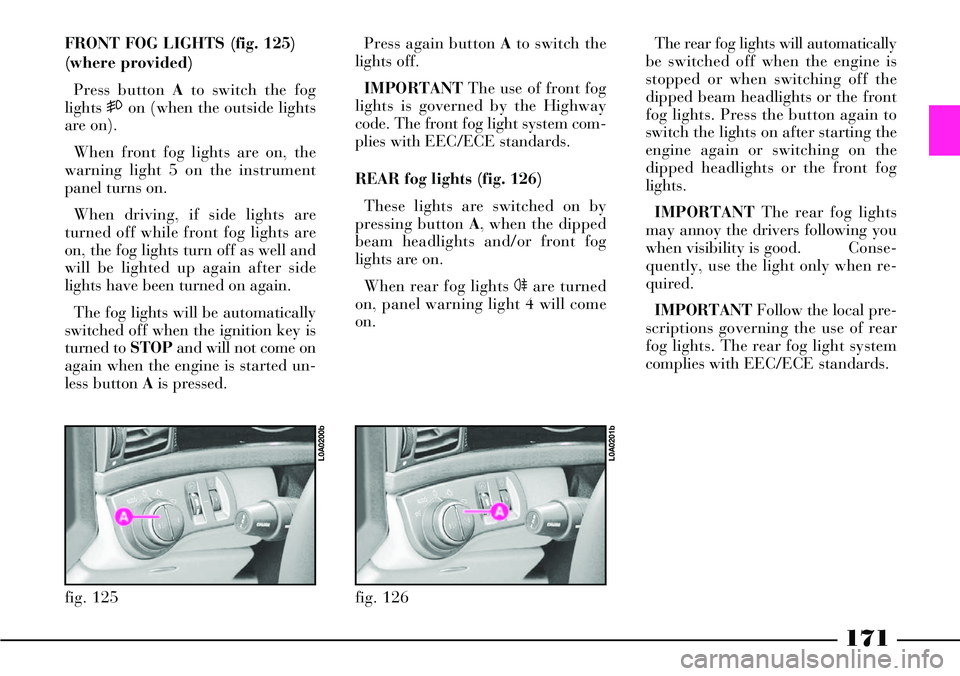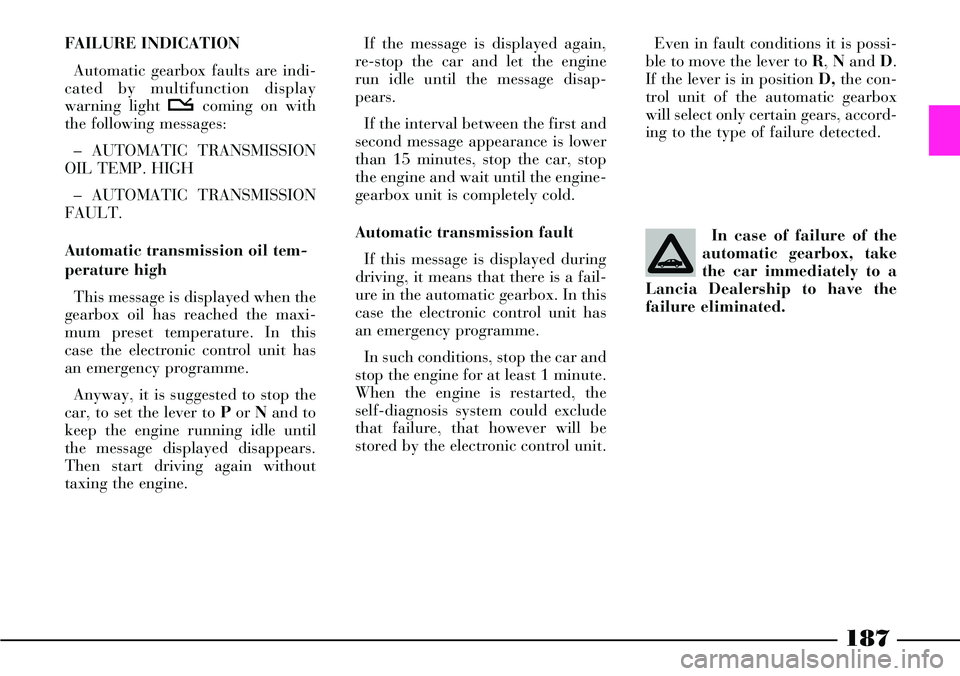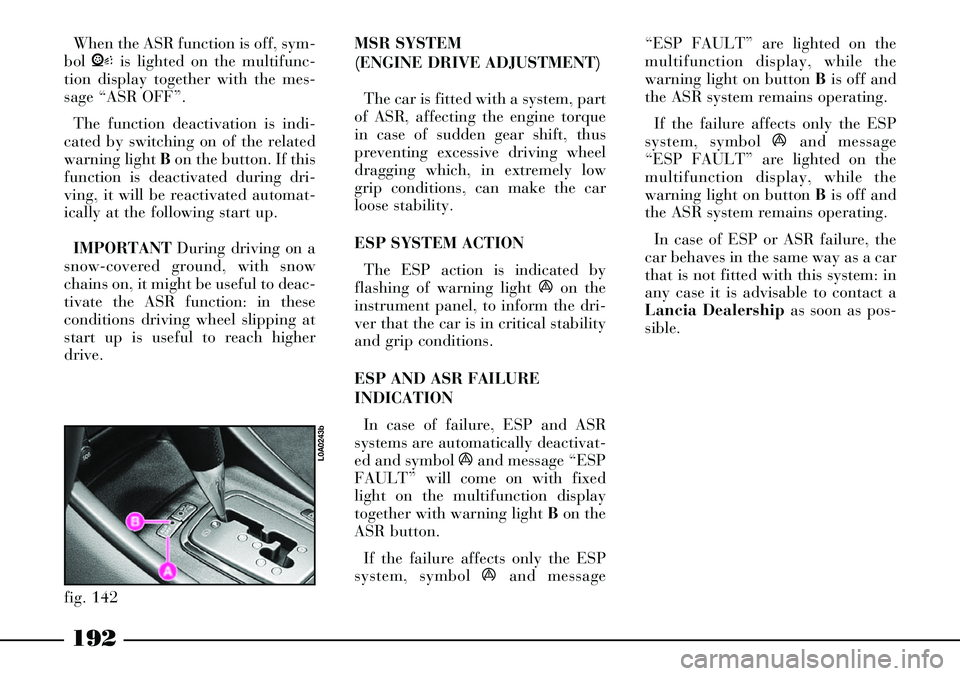warning light Lancia Thesis 2006 Owner handbook (in English)
[x] Cancel search | Manufacturer: LANCIA, Model Year: 2006, Model line: Thesis, Model: Lancia Thesis 2006Pages: 386, PDF Size: 8.69 MB
Page 141 of 386

Action
The presence of water
in the fuel circuit may
cause serious damage
to the entire injection system
and cause irregular engine
operation. If there is water in
the fuel filter or the sensor is
faulty contact a Lancia
Dealership as soon as possible
140
Parking sensors
Warning light/symbol
t
Message
PARKING SENSOR
FAULT
GO TO DEALERMeaning of the message
One or more parking sensor
failureAction
Contact a Lancia
Dealership
Diesel fuel filter (JTD versions)
Warning light/symbol
c
èc
Message
MOISTURE IN DIESEL
FUEL FILTER
GO TO DEALER
DIESEL FUEL FILTER
SENSOR FAULT
GO TO DEALERMeaning of the message
Water in diesel fuel
filter
Water in diesel fuel filter sensor
failure
Page 142 of 386

141
Twilight sensor
Warning light/symbol
1
Message
TWILIGHT SENSOR
FAULT
GO TO DEALERMeaning of the message
The twilight sensor, for switching
on/off automatically the external
lights is faultyAction
Contact a Lancia
Dealership
Engine oil level sensor (JTD versions)
Warning light/symbol
èk
Message
ENGINE OIL
LEVEL SENSOR FAULT
GO TO DEALERMeaning of the message
Engine oil level sensor
failureAction
Contact a Lancia
Dealership
Message
ANTIPOLLUTION
FILTER
CLOGGED
SEE HENDBOOK
Meaning of the message
Anti-pollution filter cloggedAction
Keep the engine running until
the symbol disappears from
the display
Antipollution filter clogged (2.4 JTD 20VCAE version)
Warning light/symbol
è
Message
CHANGE
ENGINE OILMeaning of the message
Change engine oilAction
Restore proper oil level
(see “Checking levels” in section
“Car maintenance”)
Change engine oil (2.4 JTD 20VCAE version)
Warning light/symbol
Page 171 of 386

170
CONTROLS
HAZARD LIGHTS (fig. 124)
These come on when switch Ais
pressed, regardless of the position of
the ignition key.
When these lights are on, the switch
and the direction indicator warning
lights on the instrument panel flash.
Press the switch again to turn the
lights off.
IMPORTANTThe use of hazard
lights is governed by the traffic regu-
lations of the country where the car is
being driven. These laws should be
complied with.
fig. 124
L0A0103b
Maximum heat power
Reduced heat power
Rated voltage
Operating current
Idle current
Operating voltage
Operating temperature
Fuel consumption
Weight
Noiseabout 5 kW
about 2,5 kW
12 V
45W to 13.5V; 34W to 12V
1mA (5mA with radio receiver)
10,25V ± 0,25V ÷ 15,50V ± 0,25V
- 40º C ± 2K to 70º C ± 2K
with reduced power 0,25 Kg/h
with maximum power 0,5 Kg/h
2,9 Kg
51 db.
TECHNICAL SPECIFICATIONS
Page 172 of 386

171
FRONT FOG LIGHTS (fig. 125)
(where provided)
Press button Ato switch the fog
lights 5on (when the outside lights
are on).
When front fog lights are on, the
warning light 5 on the instrument
panel turns on.
When driving, if side lights are
turned off while front fog lights are
on, the fog lights turn off as well and
will be lighted up again after side
lights have been turned on again.
The fog lights will be automatically
switched off when the ignition key is
turned to STOPand will not come on
again when the engine is started un-
less button Ais pressed.Press again button Ato switch the
lights off.
IMPORTANTThe use of front fog
lights is governed by the Highway
code. The front fog light system com-
plies with EEC/ECE standards.
REAR fog lights (fig. 126)
These lights are switched on by
pressing button A, when the dipped
beam headlights and/or front fog
lights are on.
When rear fog lights 4are turned
on, panel warning light 4 will come
on.
fig. 125
L0A0200b
fig. 126
L0A0201b
The rear fog lights will automatically
be switched off when the engine is
stopped or when switching off the
dipped beam headlights or the front
fog lights. Press the button again to
switch the lights on after starting the
engine again or switching on the
dipped headlights or the front fog
lights.
IMPORTANTThe rear fog lights
may annoy the drivers following you
when visibility is good.Conse-
quently, use the light only when re-
quired.
IMPORTANTFollow the local pre-
scriptions governing the use of rear
fog lights. The rear fog light system
complies with EEC/ECE standards.
Page 175 of 386

174
Lift cover Aset at the driver's left
and press button Bto reset the fuel
cut-off switch.
Resetting the circuit breaker
Before resetting the cir-
cuit breaker, carefully
check for any fuel leaks or
damages to the car electric devices
(e.g.: headlights).Circuit breaker is located on the left
side of the boot, inside a box directly
set and connected to the battery pos-
itive terminal.
To reach the circuit breaker:
1) Open the tailgate.
2) Loosen knob A(fig. 130) and re-
move the battery cover B.
3) Press tabs A(fig. 131) and re-
move cover B.
4) Press button A(fig. 132) to reset
the circuit breaker.Initialising the control units of
the door locks, air conditioner
and ESP system
After resetting the circuit breaker, to
restore correct door locking, air con-
ditioning and ESP system, perform
the following operations:
1) Close the doors and the tailgate,
fit the key into the lock of one of the
front doors and perform a door cen-
tralised opening/closing cycle.
2) Start the engine and turn on the
compressor of the conditioner, setting
a lower temperature value than that
of the environment and check
whether the led on the disconnection
push button of the conditioner com-
pressor òis lit.
3) Turn the steering wheel one
fourth turn at least (the car can be at
standstill but the engine shall be run-
ning) and start running the car for a
few metres in a straight line until the
ESP warning light
áis off.
fig. 131
L0A0031b
fig. 132
L0A0347b
Page 176 of 386

ELECTRIC PARKING BRAKE
(EPB) (fig. 133)
The car is fitted with the EPB
(Electric Parking Brake) that cuts in
when switching the engine off and
will cut out when starting the engine
and pressing the accelerator pedal
(for manual gearbox versions when
releasing the clutch pedal at the
same time). The EPB can also be
disengaged manually by pressing
button Aset on the central console
with engine running or ignition key
to MAR.
After disengaging the EPB manual-
ly, when opening the driver’s door
the EPB will re-engage automatical-
ly, press button Aagain to disengage
it.The button shape is rather large so
the brake can be engaged rapidly,
even by the passenger, in case of
emergency.
The advantages of this system, com-
pared to the usual lever, are several:
– no effort should be made to
engage and disengage the parking
brake
– the parking brake efficiency is
always at top level in any using con-
dition, contrary to the lever which
guarantees the car complete stop only
when fully lifted
– the EPB is controlled by electric
wires, therefore all problems regard-
ing transmission cables, such as
adjustments, freezing or tears, no
longer exist
– improved safety as a result of the
sophisticated electronic control sys-
tem, similar to the ABS one, prevent-
ing wheels from blocking if the park-
ing brake is engaged during driving
– improved safety when the car is
stationary and children are left
inside the car; in this case the brake
cannot be disengaged if the ignition
key is at STOPor removed– it has automatic functions that
other systems lack.
When the parking brake is engaged
and the ignition key is at MAR, the
instrument panel warning light x
turns on.
This warning light turns on when
the parking brake reaches its highest
working level, and it turns off when
the brake is disengaged and com-
pletely released. Unlike usual park-
ing brakes, whose warning light
turns on even when the lever is lift-
ed a little bit, the EPB system warn-
ing light turns on only when the car
has come to a complete stop.
When the brake is engaged, a typi-
cal noise can be heard by the driver;
the parking brake is completely
engaged or disengaged when the
operating noise stops.
fig. 133
L0A0197b
When engaging the park-
ing brake keep the brake
pedal always depressed.
175
Page 178 of 386

177
“Automatic parking brake” function
and the press “OK”. Deactivation of
automatic operation can be achieved
also in the following way:
– turn the key to STOP(the park-
ing brake is engaged)
– turn the key back to MAR,
depress the brake pedal and at the
same time keep button Apressed for
at least 2 seconds. Warning light x
flashes thrice to indicate the auto-
matic operation deactivation.
When the key is turned again to
STOPthe parking brake will not be
engaged. The parking brake auto-
matic operation will be automatical-
ly restored when the key is turned
again to MAR.IMPORTANTIf, after the parking
brake has been disengaged, the car
starts moving at a speed higher than
the usual manual movement, deacti-
vation of the automatic mode is
immediately cancelled and the park-
ing brake is engaged.
If, after the parking
brake has been disen-
gaged, the car starts mov-
ing at a speed higher than the
usual manual movement, deacti-
vation of the automatic mode is
immediately cancelled and the
parking brake is engaged.Proceed as follows: release the
accelerator pedal, press and keep
button A(fig. 133) pressed for the
whole manoeuvre: the system elec-
tronic control unit will come imme-
diately into action with alternate
braking on/off cycles on the rear
wheels (thus preventing wheel lock-
ing). Braking cycles are applied
alternately on right and left wheel to
guarantee roadholding, braking
continuity and to reduce braking
distance.
Wheel locking could take place
under the safety speed threshold
(lower than 10 km/h).
A buzzer will sound during the
whole manoeuvre to indicate that
the dynamic mode shall only be used
in an emergency, but this is also use-
ful to warn the driver if the parking
brake has been inadvertently
engaged by other passengers.
Use in an emergency
In particular cases (e.g. fault in the
whole hydraulic brake system, both
service and emergency brake), the
parking brake can be used to stop
the car running (“dynamic mode”).
Page 179 of 386

178
fig. 135
L0A0275b
fig. 134
L0A0274b
Fault indication
The system is controlled by an elec-
tronic control unit signalling possible
failures by turning on the s! warn-
ing light on the multifunction display
together with the message “EPB
FAULT - GO TO DEALER”.
For a higher safety, every time the
parking brake button is pressed dur-
ing a failure, a buzzer will sound to
draw the driver’s attention and the
xwarning light will turn on.
If the parking brake does not reach
the required working force (e.g.
when the battery is partially flat),
the instrument panel warning light
xstarts flashing.
In case of instrument panel warn-
ing light xfault, the s!warning
light on the multifunction display
turns on together with the message
“EPB INDICATOR FAULT - GO TO
DEALER” to informthe driver
about the dangerous situation. In case of failure indi-
cated by the related
warning light and mes-
sage turning on, drive carefully to
a Lancia Dealership because the
parking brake might not work.
Emergency disengagement
The electric parking brake is fitted
with an independent battery which
can be used to disengage the brake,
for instance when the car main bat-
tery is completely flat or it has bro-
ken after an accident.The additional battery, always
kept charged by a dedicated elec-
tronic control unit, can engage and
disengage the parking brake when it
is necessary to push manually the
car.
To engage and disengage the elec-
tric parking brake when the car
main battery is completely flat, turn
the key to MARand press the main
button on the central console.
Page 188 of 386

187
Even in fault conditions it is possi-
ble to move the lever to R, Nand D.
If the lever is in position D,the con-
trol unit of the automatic gearbox
will select only certain gears, accord-
ing to the type of failure detected.
In case of failure of the
automatic gearbox, take
the car immediately to a
Lancia Dealership to have the
failure eliminated.FAILURE INDICATION
Automatic gearbox faults are indi-
cated by multifunction display
warning light tcoming on with
the following messages:
– AUTOMATIC TRANSMISSION
OIL TEMP. HIGH
– AUTOMATIC TRANSMISSION
FAULT.
Automatic transmission oil tem-
perature high
This message is displayed when the
gearbox oil has reached the maxi-
mum preset temperature. In this
case the electronic control unit has
an emergency programme.
Anyway, it is suggested to stop the
car, to set the lever to Por Nand to
keep the engine running idle until
the message displayed disappears.
Then start driving again without
taxing the engine.If the message is displayed again,
re-stop the car and let the engine
run idle until the message disap-
pears.
If the interval between the first and
second message appearance is lower
than 15 minutes, stop the car, stop
the engine and wait until the engine-
gearbox unit is completely cold.
Automatic transmission fault
If this message is displayed during
driving, it means that there is a fail-
ure in the automatic gearbox. In this
case the electronic control unit has
an emergency programme.
In such conditions, stop the car and
stop the engine for at least 1 minute.
When the engine is restarted, the
self-diagnosis system could exclude
that failure, that however will be
stored by the electronic control unit.
Page 193 of 386

192
When the ASR function is off, sym-
bol Vis lighted on the multifunc-
tion display together with the mes-
sage “ASR OFF”.
The function deactivation is indi-
cated by switching on of the related
warning light Bon the button. If this
function is deactivated during dri-
ving, it will be reactivated automat-
ically at the following start up.
IMPORTANTDuring driving on a
snow-covered ground, with snow
chains on, it might be useful to deac-
tivate the ASR function: in these
conditions driving wheel slipping at
start up is useful to reach higher
drive.MSR SYSTEM
(ENGINE DRIVE ADJUSTMENT)
The car is fitted with a system, part
of ASR, affecting the engine torque
in case of sudden gear shift, thus
preventing excessive driving wheel
dragging which, in extremely low
grip conditions, can make the car
loose stability.
ESP SYSTEM ACTION
The ESP action is indicated by
flashing of warning light áon the
instrument panel, to inform the dri-
ver that the car is in critical stability
and grip conditions.
ESP AND ASR FAILURE
INDICATION
In case of failure, ESP and ASR
systems are automatically deactivat-
ed and symbol áand message “ESP
FAULT” will come on with fixed
light on the multifunction display
together with warning light Bon the
ASR button.
If the failure affects only the ESP
system, symbol áand message“ESP FAULT” are lighted on the
multifunction display, while the
warning light on button Bis off and
the ASR system remains operating.
If the failure affects only the ESP
system, symbol áand message
“ESP FAULT” are lighted on the
multifunction display, while the
warning light on button Bis off and
the ASR system remains operating.
In case of ESP or ASR failure, the
car behaves in the same way as a car
that is not fitted with this system: in
any case it is advisable to contact a
Lancia Dealershipas soon as pos-
sible.
fig. 142
L0A0243b